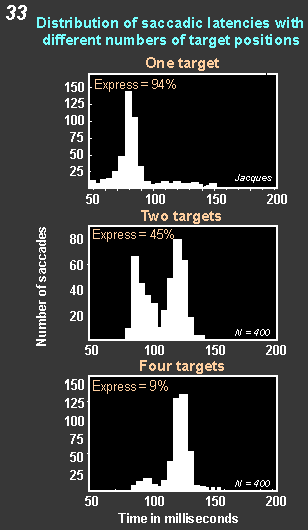The Neural
Control of Visually Guided Eye Movements
D. Temporal Factors in Visually Guided Saccadic Eye Movements
1. The conditions under which express
saccades can and cannot be generated.
d. Does the number of target locations used in
a given sample at which a single target is presented affect the frequency
with which express saccades are generated?
 Figure
33 shows the distribution of saccadic latencies when one,
two or four target locations are used in the sample. On each trial a single
target appears at one of these locations arranged in a randomized order.
For each set the animal was run repeatedly for more than 400 trials. Exposure
to each condition for 30-50 trials before data collection prepares the
animal for the condition. The data show that there is a dramatic decrease
in the number of express saccades made as the sample size of target positions
increases. This monkey made few express saccades when four target locations
were used. Thus the number of expected target positions used in any given
sample is an important variable: the larger the sample, the fewer the
number of express saccades. Figure
33 shows the distribution of saccadic latencies when one,
two or four target locations are used in the sample. On each trial a single
target appears at one of these locations arranged in a randomized order.
For each set the animal was run repeatedly for more than 400 trials. Exposure
to each condition for 30-50 trials before data collection prepares the
animal for the condition. The data show that there is a dramatic decrease
in the number of express saccades made as the sample size of target positions
increases. This monkey made few express saccades when four target locations
were used. Thus the number of expected target positions used in any given
sample is an important variable: the larger the sample, the fewer the
number of express saccades.
|